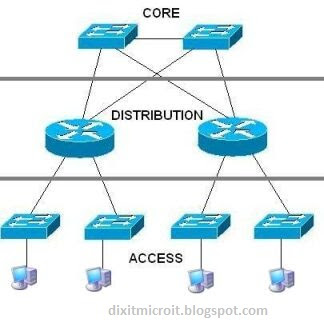The Cisco Three-Layer Hierarchical Model
hierarchy that helps us understand where things belong, how things fit together, and what functions go where.
Hierarchy has many of the same benefits in network design when used properly, it makes networks more predictable. It helps us define which areas should perform certain functions like as which router should be placed where, where we should apply access list, etc.
The Cisco hierarchical model can help you design, implement, and maintain a scalable, reliable hierarchical internetwork. Cisco defines three layers of hierarchy.
The following are the three layers (figure 1.0) and their typical functions:
The core layer: backbone
The distribution layer: routing
The access layer: switching
Each layer has specific responsibilities.
1-Core Layer:
The core layer is responsible for transporting large amounts of traffic both reliably and quickly. The responsibility of core layer is to switch traffic as fast as possible. If there is a failure in the core, every single user can be affected.
Things to not do:
A-Don’t do anything to slow down traffic. like as access lists, intervlan routing, and packet filtering.
B-Avoid expanding the core (adding devices) when the internetwork grows its performance may be affected.
Things to do:
A-Design the core for high reliability. redundancy, such as Gigabit Ethernet (backup links)
B-Design with speed in mind. The core should have very little latency.
C-Select routing protocols with lower convergence times.
The Distribution Layer:
The distribution layer is also called workgroup layer and is the communication point between the access layer and the core. The primary functions of the distribution layer are to provide routing, filtering, and WAN access.
Actions that generally should be done at the distribution layer:
A-Implementing security (access lists) and network policies, NAT and firewalls.
B-Redistributing between routing protocols, including static routing.
C-Routing between VLANs.
D-Defining broadcast and multicast domains.
The Access Layer
The access layer controls user and workgroup access to internetwork resources. The access layer is sometimes referred to as the desktop layer.
The following are some of the functions of access layer:
A-Use of access control and policies
B-Creation of separate collision domains (segmentation)
C-Workgroup connectivity into the distribution layer
D-Technologies such as Gigabit or Fast Ethernet switching are often used with this layer.
hierarchy that helps us understand where things belong, how things fit together, and what functions go where.
Hierarchy has many of the same benefits in network design when used properly, it makes networks more predictable. It helps us define which areas should perform certain functions like as which router should be placed where, where we should apply access list, etc.
The Cisco hierarchical model can help you design, implement, and maintain a scalable, reliable hierarchical internetwork. Cisco defines three layers of hierarchy.
The following are the three layers (figure 1.0) and their typical functions:
The core layer: backbone
The distribution layer: routing
The access layer: switching
 |
| Figure 1.0 |
1-Core Layer:
The core layer is responsible for transporting large amounts of traffic both reliably and quickly. The responsibility of core layer is to switch traffic as fast as possible. If there is a failure in the core, every single user can be affected.
Things to not do:
A-Don’t do anything to slow down traffic. like as access lists, intervlan routing, and packet filtering.
B-Avoid expanding the core (adding devices) when the internetwork grows its performance may be affected.
Things to do:
A-Design the core for high reliability. redundancy, such as Gigabit Ethernet (backup links)
B-Design with speed in mind. The core should have very little latency.
C-Select routing protocols with lower convergence times.
The Distribution Layer:
The distribution layer is also called workgroup layer and is the communication point between the access layer and the core. The primary functions of the distribution layer are to provide routing, filtering, and WAN access.
Actions that generally should be done at the distribution layer:
A-Implementing security (access lists) and network policies, NAT and firewalls.
B-Redistributing between routing protocols, including static routing.
C-Routing between VLANs.
D-Defining broadcast and multicast domains.
The Access Layer
The access layer controls user and workgroup access to internetwork resources. The access layer is sometimes referred to as the desktop layer.
The following are some of the functions of access layer:
A-Use of access control and policies
B-Creation of separate collision domains (segmentation)
C-Workgroup connectivity into the distribution layer
D-Technologies such as Gigabit or Fast Ethernet switching are often used with this layer.
No comments:
Post a Comment